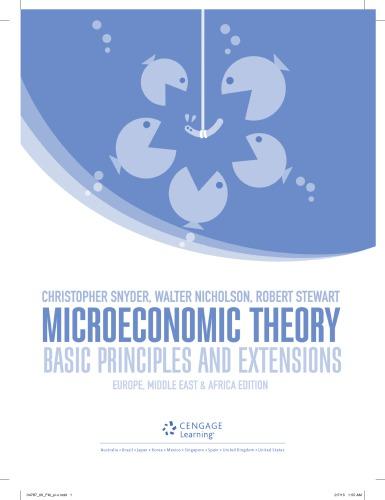15.10 Competition on a circle Steven Salop introduced competition on a circle.18 As in the Hotelling model,
Question:
15.10 Competition on a circle Steven Salop introduced competition on a circle.18 As in the Hotelling model, demanders are located at each point, and each demands one unit of the good. A consumer’s surplus equals v (the value of consuming the good) minus the price paid for the good as well as the cost of having to travel to buy from the firm. Let this travel cost be td, where t is a parameter measuring how burdensome travel is and d is the distance travelled (note that we are here assuming a linear rather than a quadratic travel-cost function, in contrast to Example 15.5).
Initially, we take as given that there are n firms in the market and that each has the same cost function Ci = K + cqi, where K is the sunk cost required to enter the market [this will come into play in part
(e) of the question, where we consider free entry] and c is the constant marginal cost of production. For simplicity, assume that the circumference of the circle equals 1 and that the n firms are located evenly around the circle at intervals of 1/n. The n firms choose prices pi simultaneously.
a.
Each irm i is free to choose its own price ( pi) but is constrained by the price charged by its nearest neighbour to either side. Let p* be the price these irms set in a symmetric equilibrium. Explain why the extent of any irm’s market on either side (x) is given by the equation p + tx = p* + t [(1/n) − x].
c.
d.
e.
f.
Given the pricing decision analysed in part (a), irm i sells qi = 2x because it has a market on both sides. Calculate the proit-maximising price for this irm as a function of p*,
c, t and n.
Noting that in a symmetric equilibrium all irms’
prices will be equal to p*, show that pi = p = c +
t/n. Explain this result intuitively.
Show that a irm’s proits are t/n2 − K in equilibrium.
What will the number of irms n* be in long-run equilibrium in which irms can freely choose to enter?
Calculate the socially optimal level of differentiation in this model, deined as the number of irms (and products) that minimises the sum of production costs plus demander travel costs. Show that this number is precisely half the number calculated in part (e). Hence this model illustrates the possibility of over differentiation.
Step by Step Answer:

Microeconomic Theory Basic Principles And Extensions
ISBN: 9781473729483
1st Edition
Authors: Christopher M Snyder, Walter Nicholson, Robert B Stewart






